 Export ->
Export ->  Export questionnaires
... from the menu to open the window for the export.
Export questionnaires
... from the menu to open the window for the export.
With this form you can export description data from the database to HTML forms. You can open
the generated HTML files, edit the data in the form and re-import the changes by using the
import questionaire data function. Choose Data ->
 Export ->
Export ->  Export questionnaires
... from the menu to open the window for the export.
Export questionnaires
... from the menu to open the window for the export.
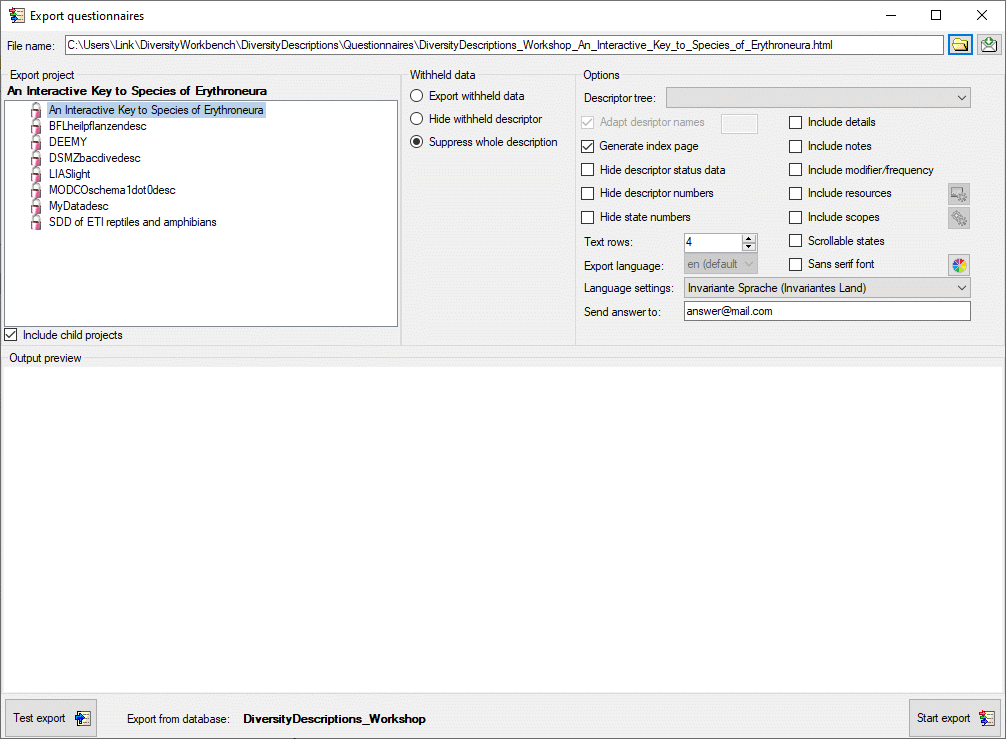
In the Export project section all projects of the database are shown as a tree. Select
here the project that shall be exported. In case of hierarchically organized projects the subordinated projects will be included
for export, if the Include child projects option is checked. You may pass a description list to the form by starting
a query in mode "Edit descriptions". If all descriptions in the list belong to the same project, you have the option
to select single descriptions for export. In this case the Export project section shows the button  to switch to the list view (see below).
to switch to the list view (see below).
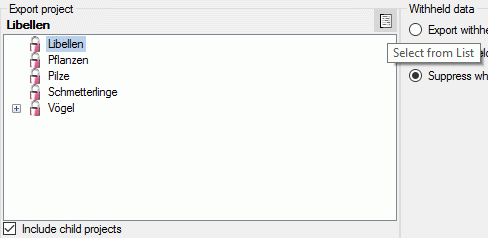
In the Expot descriptions section you find all description titles that have been passed
to the export form (see below). You may select all entries by clicking the
 all button, deselect all entries by clicking the
all button, deselect all entries by clicking the
 none button or toggle your selection by clicking the
none button or toggle your selection by clicking the
 swap button. By clicking the button
swap button. By clicking the button
 you will return to the Export project view.
you will return to the Export project view.
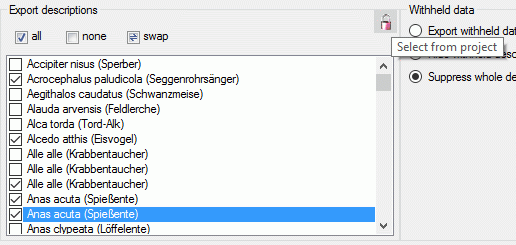
The Withheld data section allows control over export of datasets that contain entries with data status "Data withheld". Option Supress whole description (default) excludes all descriptions form export where at least on descriptor is marked with "Data withheld". Option Hide withheld descriptor excludes only the corresponding descriptor data from the description. Option Export withheld data does not exclude any data from export.
The Options section allows the selection of a Descriptor tree to determine the sequence and selection of descriptors for output. If a structured descriptor tree is selected, the first level descriptor tree nodes will be inserted as headers to structure the document. If option Adapt descriptor names is checked, the descriptor names will be prefixed with the headers from the derscriptor tree. In this case you may specify a string to connect the names in the texrt box at the right of the option. If Generate index page is checked, an alphabetically sorted index with links to the individual description pages will be generated.
You may Hide descriptor status data in the generated forms. Furthermore output of the ordinal numbers for descriptors rsp. categorical states may be suppressed by using the options Hide descriptor numbers rsp. Hide state numbers. With options Include notes and Include modifier/frequency you can control if notes and modifier or frequency values shall be included in the generated questionaires. With Include details a text field for editing the item details will be inserted.
By default a font type with serifes is used for the HTML output, select Sans serif font
for an alternative. The colors of several HTML elements may be adapted to the personal preferences by clicking on button
 . With Text rows you can adjust the size of text boxex used for text and
molecular sequence descriptors. Option Scrollable states generates an alternative layout for categorical
descriptors, where the state values are arranged in scroll boxes.
. With Text rows you can adjust the size of text boxex used for text and
molecular sequence descriptors. Option Scrollable states generates an alternative layout for categorical
descriptors, where the state values are arranged in scroll boxes.
Check Include resources to include images for descriptions, descriptors, categorical
states and descriptor tree nodes in the questionnaire. In the generated HTML questionnaire the images will be zoomed by a
dedicated factor, when the mouse cursor is moved over it. The zoom factors may be adjusted by clicking on button
 . If you check the option Insert fields for new resources,
the specified number of input fields for entering new description resources (name and URL) will be inserted in the forms (see
image below on the left).
. If you check the option Insert fields for new resources,
the specified number of input fields for entering new description resources (name and URL) will be inserted in the forms (see
image below on the left).
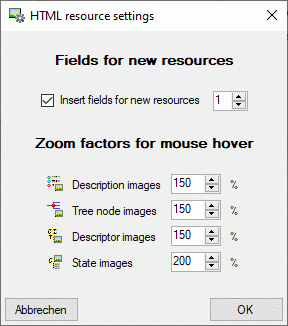
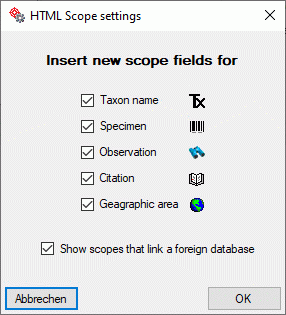
Check Include scopes to include a section for scope data in the questionnare. The scope values of the types "Sex", "Stage", "Part" and "Other scopes", which may be administered in the Edit project section, are included as check boxes. For the other (general) scope types input boxes will be generated, where new values may be entered or existing values can be edited. If a scope value is linked to a database entry, e.g. of a DiversityTaxonNames database, it cannot be modified. In this case only a fixed text with the reference to the target database will be inserted in the questionnaire.
By clicking on button  you may open an option window
where you can change this default behaviour. You may adjust for which scope types an input box for a new scope value shall
be inserted or if scopes that cannot be modified shall be displayed (see image above on the right).
you may open an option window
where you can change this default behaviour. You may adjust for which scope types an input box for a new scope value shall
be inserted or if scopes that cannot be modified shall be displayed (see image above on the right).
See below an example of a questionnaire where imput fields for a new description resource and all general scope types are present..
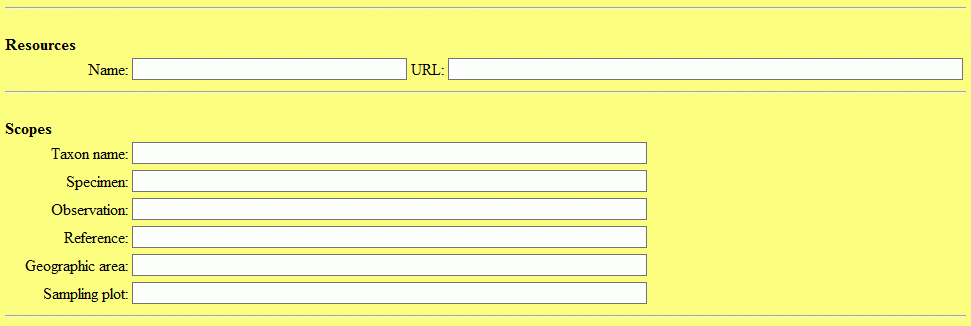
If for the selected projects translations are stored in the database, you may chose the Export language. If for any element no translation in the chosen export language is present, automatically the original text will be used. With field Language settings you can control the presentation of floating point values in the output, in field Send answer to you may enter the mail address to return the results.
To check the export, click on the Test export
 button. In the Output preview
section an empty form for entering a new item will be displayed (see picture below). The file name is generated as <resources
directory>\Questionnaires\<Database name>_<Project>.txt. This default setting may be changed by
editing the File name or by navigating at the target location by pressing the
button. In the Output preview
section an empty form for entering a new item will be displayed (see picture below). The file name is generated as <resources
directory>\Questionnaires\<Database name>_<Project>.txt. This default setting may be changed by
editing the File name or by navigating at the target location by pressing the
 button besides the file name. Button
button besides the file name. Button
 opens the form in an external web browser.
opens the form in an external web browser.
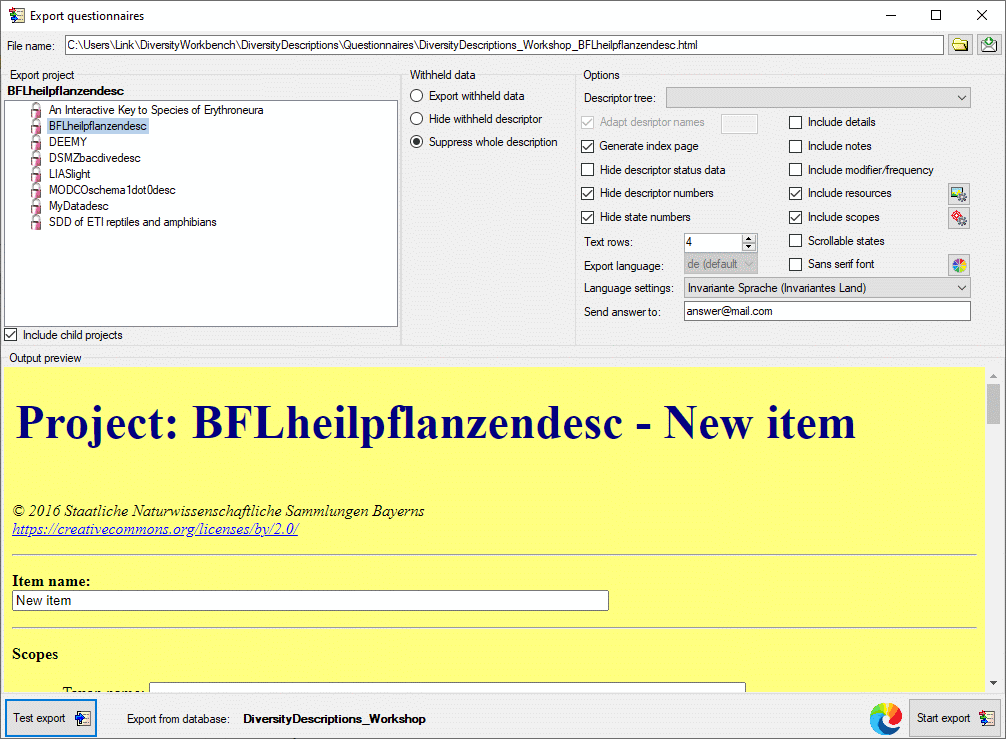
Since the generated form can be opened with any modern web broswer, you may distribute it to easily collect item data by people that do not have access to the Diversity Descriptions database. Even if the form is published as a web page, the collected data stay completele local in the user's web browser and are not uploaded to any server. To get the data into the database, they must be "downloaded" form the form and sent back to a database editor for import (see item Send reply below).
Before starting the export, the export file name should be checked. The file name is generated
as <resources directory>\Questionaires\<Database name>_<Project>.html.
This default setting may be changed by editing the File name or by navigating at the target location by pressing
the  button besides the file name text box. During export a number
of HTML files will be generated. The document for entering a new item has the specified file name. For entries present in
the database the description id is appended. Furthermore an index file with postfix "_Index" will be generated,
where you may navigated to each exported questionnaire.
button besides the file name text box. During export a number
of HTML files will be generated. The document for entering a new item has the specified file name. For entries present in
the database the description id is appended. Furthermore an index file with postfix "_Index" will be generated,
where you may navigated to each exported questionnaire.
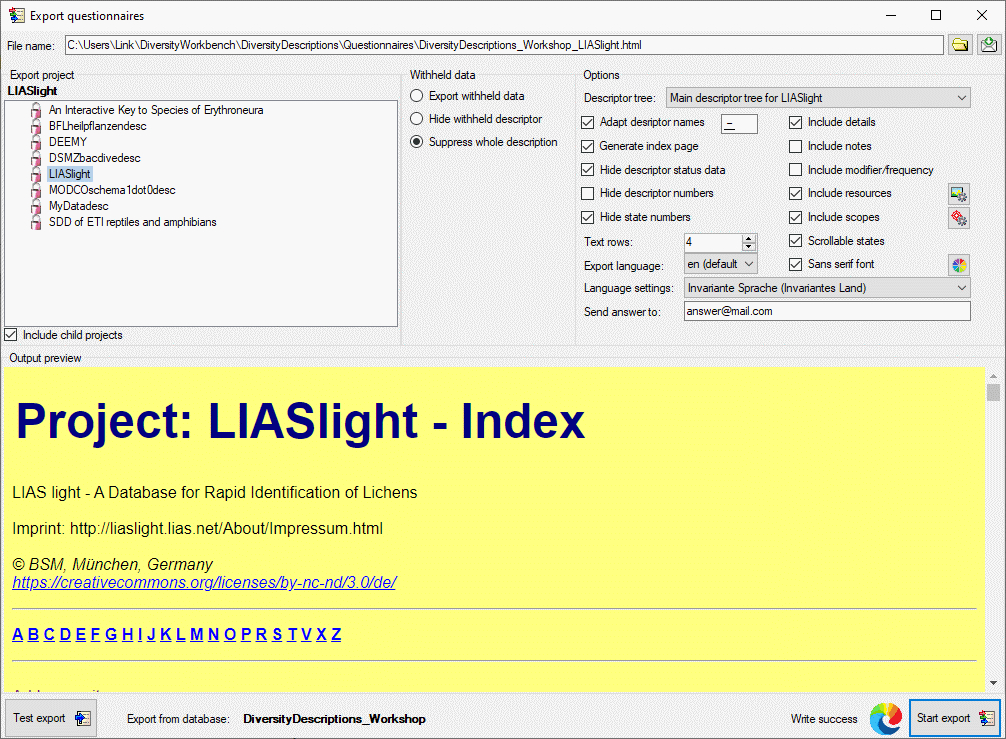
To generate the HTML files press the Start export
 button. During export the icon of the
button changes to
button. During export the icon of the
button changes to  and you may abort processing by clicking the button. Button
and you may abort processing by clicking the button. Button
 opens the form visible in the Output preview section in an external
web browser (see image above).
opens the form visible in the Output preview section in an external
web browser (see image above).
When you opened a HTML form in the web browser and modified data, you may download them as a text file for database import. At the bottom of the HTML form click the button Download revised description (see image below). Data collection is completely done in the user's local web browser, nothing is uploaded to a server. Since data collection is done using javascript, please take care that the script is not blocked by the web browser.
